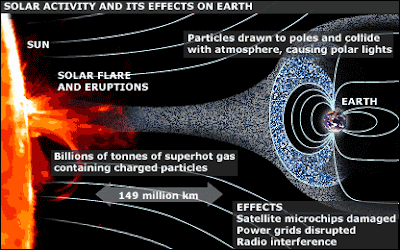With fluke
experiment of solar flare measurement, scientists confirmed that the Voyager I
exited the solar system. When I started curiously to find out meaning of the word
“Solar flare”, it took me to unravel mysterious theories surrounding the solar
flare and Earth. It is amazing to know the fact that, we are connected to sun,
not only through light, also by stream of charge particles which Sun often releases.
The Sun produces a hot gas that travels
through space at a million miles per hour, carrying particles and magnetism
outward past the planets called the solar wind. Solar wind is a near continuous
fairly gentle outflow of gas from the sun in all directions. When this solar
wind becomes a giant hurricane force gust blown suddenly away from the sun in
one single direction, its known as solar flare. Since the Earth is immersed in
the Sun's atmosphere, any changes on the Sun affects the solar wind flow,
paving the way for creation of solar flares with strong gusts of solar wind. Solar
flares are followed by colossal coronal mass ejection commonly known as CME. Clouds
of ions, electrons and atoms are ejected with CME.
High energy particles (high energy protons) and electromagnetic
(X-Rays) radiations released by solar flare are highly hazardous to living organisms.
But now question remains is how the earth got survived from these murderous
flares for past 4.5 billion years? The answer lies with our earth’s magnetic field
which repels these particles away from reaching us. Lack of this magnetic field
in other rocky planets like Mars and Venus, made them to become sitting ducks
for the murderous CME. During Sun’s initial years, CME was reported to be very
high that it completely destroyed the atmosphere of these planets making them
dead planet with no life support.
Solar winds constantly bombard the earth. The earth (in center)
is protected by its magnetic field. The more active the sun, the
greater the solar winds and the more cosmic radiation from deep
space is pushed back, which seems to have a dramatic effect on
the earth's climate by warming the earth.
Earth Magnetic Field
Before transverse more about the solar flare, here is the
quick summary of earth magnetic field.Our planet’s
magnetic field is believed to be generated deep down in the Earth’s core.As
still nobody has ever traversed to the center of the Earth, but by analyzing
the way shock waves from earthquakes travel through the planet, physicists have
been able to work out its likely structure.
Right at the
heart of the Earth is a solid inner core, two thirds of the size of the Moon
and composed primarily of iron. At a hellish 5,700°C, this iron is as hot as
the Sun’s surface, but the crushing pressure caused by gravity prevents it from
becoming liquid.Surrounding this is the outer core, a 2,000 km thick layer of
iron, nickel, and small quantities of other metals. Lower pressure than the
inner core means the metal here is fluid. Differences in temperature, pressure
and composition within the outer core cause convection currents in the molten
metal as cool, dense matter sinks whilst warm, less dense matter rises. The
Coriolis force, resulting from the Earth’s spin, also causes swirling
whirlpools.
This flow of liquid iron generates electric currents, which in turn produce magnetic fields. Charged metals passing through these fields go on to create electric currents of their own, and so the cycle continues. This self-sustaining loop is known as the geodynamo.
The spiralling caused by the Coriolis force means that separate magnetic fields created are roughly aligned in the same direction, their combined effect adding up to produce one vast magnetic field engulfing the planet.
This flow of liquid iron generates electric currents, which in turn produce magnetic fields. Charged metals passing through these fields go on to create electric currents of their own, and so the cycle continues. This self-sustaining loop is known as the geodynamo.
The spiralling caused by the Coriolis force means that separate magnetic fields created are roughly aligned in the same direction, their combined effect adding up to produce one vast magnetic field engulfing the planet.
Effects of CME in Earth
When a CME reaches the Earth, its impact disturbs the
Earth's magnetosphere, setting off a geomagnetic storm. During periods of gusty solar flares
and coronal mass ejections, these powerful geomagnetic storms in space near the
Earth cause vivid auroras, radio and television static, power blackouts,
navigation problems for ships and airplanes with magnetic compasses, and damage
to satellites and spacecraft. There is no immediate danger for Astronauts on as
their manned missions are generally in low orbit. They do have to be concerned
about cumulative exposure during space walks. The energetic particles from a
flare or CME would be dangerous to an astronaut while on a mission to the Moon
or Mars.
Whenever geomagnetic storms appear,major problem that has
occurred has been the temporary loss of electrical power over a large region.
The best known case of this occurred in 1989 in Quebec. High currents in the magnetosphere
induce high currents in power lines, blowing out electric transformers and
power stations. This is most likely to happen at high latitudes, where the
induced currents are greatest, and in regions having long power lines and where
the ground is poorly conducting.
Could a solar flare or CME be large enough to cause a
nation-wide or planet-wide cataclysm? Scientists reply with skeptical mood that
It is, of course, impossible to give a definitive answer for this question. But
no such event is known to have occurred in the past and there is no evidence
that the Sun could initiate such an event.
Sources: Wikipedia ,other science magazines,NASA


